#benjamin c note franklin
Explore tagged Tumblr posts
Text

5 notes
·
View notes
Text
Guys… You know what I’m here for, right? Yeah, to talk about my current hyper fixation, Prison Break.
As always, spoilers for season 4 under the cut
I’m in the S04E23, and I have a hell of a lot to talk about it.
Firstly, Christina Scofield, I hate you like I never hated another character in my life, I hate you more than I hate Esther Mikaelson, and I never thought that would be possible. How can you think so low of Lincoln?!? Like, I get that you don’t feel maternal love for him, but why do you hate him so much?!? The guy used to go everyday to see you in the hospital, you ungrateful bitch.
Also, loved how Michael was totally ready to first drown and then shoot his own mother for Lincoln and the crew, but I kinda wished he had actually killed someone, maybe Christina herself, but I think that the General would be the perfect choice.
Secondly, WHEN IS MY BABYGIRL SARA GOING TO HAVE MORE THAN AN HOUR OF PEACE AND HAPINNESS?!? Just let her be happy, this woman already suffered so much.
Now, let’s talk about Mahone. Like, I love Mahone so freaking much, he’s my second favorite character, right after T-Bag, but we’ll get on that subject later on. Anyways, Mahone was perfect almost the entire season, but he fucked up now betraying Michael to have his job back, but considering that in the 4 years time-skip he was there with everyone, I imagine he redeemed himself, so I’m gonna wait and see.
Another thing, why in seven hells didn’t they showed us when Michael and Sara finally had sex?!? Me and my sis were waiting for that moment, and they just don’t show us?!? I’m outraged.
Ohh, and C-Note’s and Kellerman’s returns? I FUCKING SCREAMED in my living room. Loved it, and loved to have them back, together with my favorite boy Sucre
And lastly, for the moment everyone knew was coming, let’s discuss my dear T-Bag.
So, after like ten episodes of Teddy being the nice guy, he suddenly remembered that he’s a psycho and went three whole seasons back to how he was in Fox River, even doing the pocket thing? Like, I really don’t get. The writers took three seasons trying to redeem an irredeemable character, by stopping showing scenes of him trying to assault a child, and never again talking about the whole pet thing he used to do in prison, only to now throw all that in the trash by making him be that disgusting with Sara. And, of course, I have to mention what Sara said about T-Bag’s apparent neurologic ED, because I have a lot of questions. He can’t get it up if not by causing pain in someone? He can’t get it up at all? But then, he never had sex with Susan Hollander? And what about the mail woman? She seemed rather satisfied after having sex with him. And, I got a few spoilers, and don’t T-Bag has a son, or something like that? How can he have a son if he can’t get it up? Maybe he can do it, but it’s just hard, or doesn’t last long? So how was that woman so satisfied? Did he learned a few other tricks? Like I said, a lot of questions, and no answers.
I see now that I already wrote way too much, so here I say my goodbyes for now. Tomorrow when I finish the season and watch the movie, I obviously will have a lot to say.
Good night everyone, and kisses from Brazil
#prison break#t-bag#theodore bagwell#sara tancredi#alexander mahone#damn I definitely exaggerated#Lincoln Burrows#Michael Scofield#fernando sucre#c-note#benjamin franklin#paul kellerman
6 notes
·
View notes
Text
The letters and their values: A-E
<a>: Almost always a low vowel, with the exception of certain English-derived alphabets: in Saanich, <A> writes the [ɛ] allophone of /e/ <Á> that occurs adjacent to postvelars, and in the orthographic tradition initiated by the North American missionary Jotham Meeker (1804-1855), designed around the constraints of standard type for newspapers and bearing substantial influence from English (perhaps owing to Meeker's lack of formal education), <a> writes either /a/ or /e/ depending on language - consider, for example, the Shawnee form Sieiwinoweakwa /sajaːwanoːwijeːkwe/, with <a e i> /e i a/. (Vowel length was unwritten.) Meeker's alphabets are no longer used.
Some derivatives of <a> exist, most notably <æ>, an a-e ligature that came to be used in Germanic languages for /æ/, and in Ossetian for schwa, which the Swedish linguist Anders Sjögren heard as a type of e and compared to Finnish ä. This ligature developed in parallel into 'e caudata', an e with a bottom curl as a remnant of <a>, which later developed into <ę>; this usage is now extinct. A reversed <a>, <ɐ>, has common use in phonetic alphabets, presumably owing to ease of printing; in addition to IPA and the Uralic Phonetic Alphabet (where rotation has systematic meaning), William Price used it in his Cornish alphabet for 'A in all, small, &c.', and the Fraser script - a descendant of Latin, but not a form of it - uses <ꓯ> for /ɛ/.
<b>: Almost always a lenis labial plosive; an exception is one of the three competing alphabets for Mapudungun, where it writes /l̪/. Occasionally a tone letter, as in the Romanized Popular Alphabet for Hmong - pob /pó/. Frequently repurposed in the Meeker orthographies: /ju/ or /joː/ in Unami (note that Deseret and Shavian, de novo orthographies for English, both define a character for English /juː/), and /θ/ in Shawnee, as in the name of Meeker's newspaper, Siwinowe Kesibwi /saːwanoːwi kiːsaʔθwa/.
<c>: In Latin, /k/, which was palatalized before front vowels in the Romance languages, producing alternations like <ca ce> /ka tʃe/. Adopted for /ts/ in most of the languages of Central and Eastern Europe, in a usage codified at least by De orthographia bohemica, a work standardizing Czech orthography, traditionally attributed to Jan Hus. /tʃ/ in Sanskrit romanization as a compromise between English <ch> and Sanskrit's four-way stop contrast, and in Malay as a compromise between English-influenced <ch> and Dutch-influenced <tj>; similarly, /ʃ/ in some North African languages, probably as a simplification of French <ch> /ʃ/. /k/ in Vietnamese (before nonfront vowels; otherwise /k/ <k>) and Saanich (in all positions, but /k/ is rare) by the influence of Portuguese and English respectively. /e/ and /ə/ in Meeker's orthography for Unami; it was left over because Meeker used <h> for /tʃ/. (This is paralleled, but certainly not inspired, by Benjamin Franklin's earlier use of derivatives of <h> for all of /ʌ ð θ ʃ/.)
Etruscan and Old Latin had three letters for the velar plosives, <c k q>, depending on the following vowel; these usages are preserved in the names of the letters, originally /ke ka ku/. In Latin, <c> displaced <k> (which came to be primarily used in, and even as an abbreviation for, the word kalendae and derivatives; English ought to spell it kalendar), but with the common use of <k> in modern non-Romance orthographies other than English (which preserves a general preference for <c> over <k> where permissible) <c> came to be seen as a repurposable 'free letter' with no particular attachment to any sound value, hence its use for /ð/ in Fijian, /|/ (a dental click) in Sandawe, Hadza, and the Nguni languages.
Sometimes <c> derives its value from its resemblance to another character, as with /ʕ/ in Somali from <ʕ>, /dʒ/ in Turkish from <ج>, and /ɔ/ in Natqgu from <ɔ>.
<ç> originated as a form of <z> - z -> ʒ -> Ꝣ -> ç - but is now treated as <;c> with a diacritic, the cedilla, which was extracted and attached to <s> to form the Turkish letter <ş>.
<d>: Generally a lenis coronal plosive; sometimes used for /θ/ or /ð/, esp. in languages without a voicing contrast in plosives. Alexandre de Rhodes used <d>, by analogy to Portuguese, for the Middle Vietnamese dental approximant /ð̞/ that developed from *t by lenition after a preinitial (e.g. dái 'scrotum' ~ Thavung ktaal3) and from Proto-Vietic *j; this sound later shifted to /z/ in the north and /j/ in the south.
<e>: Generally /e/, /ə/, or (as in many Western European languages and Malay) both. /ɣ/ in Aklanon, as in the tongue-twister /ro kaɣamaj nagakuɣuɣaput sa kaɣahaʔ/ Ro kaeamay nagakueoeaput sa kaeaha. (from p. 22 of the Peace Corps manual). /i/ in the Meeker orthographies by influence from English; Saanich, however, has <E> /ə/.
From <e> the letter <ɛ> was derived. I'm not sure what its history is; the first occurrence I'm aware of is in Isaac Pitman's English Phonotypic Alphabet, where it was used for a long vowel /iː/ as in <ɛl> 'eel', replacing an earlier barred I.
(The original phonotypic alphabet was unicameral, with six basic vowels, e a ah au o oo written I ⵎ Λ O U and a letter like a capital ꭐ without the middle dot, and an 'obscure vowel' written with a reversed ⵎ. To this was added vowel length, written with a middle line, and the three diphthong letters Ɯ (e-oo), ⚻ (ah-e), and ȣ (au-oo); CHOICE, or au-e, was written with the digraph <ƟƗ>. This scheme was quickly abandoned, and the 1847 version was bicameral and contained <ɛ>.)
This phonotypic <ɛ> is probably the source of the Deseret letter <𐐩> /ej/ - which, however, was originally written backwards: the 1854 handout presented to the Board of Regents of the Deseret University has <3𐐣> 'aim', but it was reversed a year later. (The Mormon hierarchy almost adopted Pitman's phonotype as the basis for their planned orthographic reform, but decided against it at the last minute.)
An 1879 proposal for an Albanian alphabet used <ɛ e> for /e ə/, presumably from Greek and French respectively (also <r p> /ɾ r/), and Otto Jespersen used <ɛ> for the mid front vowel [e̞] in his 1890 phonetic alphabet. It was later adopted for its current use in IPA and many African alphabets. Due to its resemblance to Arabic <ع>, it's also used in some Berber Latin alphabets for the voiced pharyngeal fricative /ʕ/.
43 notes
·
View notes
Photo

Rockmond Dunbar (born January 11, 1973) is an actor, known for his roles as Baines on Earth 2, Kenny Chadway on Soul Food, and Benjamin Miles "C-Note" Franklin on Prison Break. He played Sheriff Eli Roosevelt on Sons of Anarchy, FBI Agent Dennis Abbott on The Mentalist, FBI Agent Abe Gaines in The Path, and Michael Grant on 9-1-1. He was born in Oakland. He attended Oakland Technical High School and graduated from Morehouse College before moving on to study at the College of Santa Fe and the University of New Mexico. TV Guide named him as one of "Television's 50 Sexiest Stars of All Time". He starred in Heartland. He made a guest appearance on Noah's Arc as himself. He had a recurring role in Girlfriends and is known for his role as "Pookie" on The Game. He was a regular on Terriers. His other TV credits include guest appearances in Earth 2, Felicity, The Pretender, Two Guys and a Girl, and North Shore. In February 2022 it was reported that he sued the makers of the show, saying he "was denied medical and religious exemptions and faced racial discrimination." On July 25, 2022, it was reported that his case of racial misconduct was dismissed as baseless by a judge in a Los Angeles Courtroom, but that Disney/Fox does face some claims from him alleging religious, retaliation, and breach of contract, among other claims. His film projects include Punks (which debuted at the 2000 Sundance Film Festival), Misery Loves Company, Sick Puppies, Whodunit, Dirty Laundry, All About You, Kiss Kiss Bang Bang, and The Family That Preys. He has contributed to the art world through the mixed media exhibit, ARTHERAPY. He posed for the November 2003 issue of Playgirl magazine. He married Ivy Holmes (2003-2006). He married Maya Gilbert (2012-), an actress and writer. #africanhistory365 #africanexcellence https://www.instagram.com/p/CnT_b6TOatY/?igshid=NGJjMDIxMWI=
1 note
·
View note
Text
Today's Daily Article Thursday, September 12, 2024
Goals
"Good planning and hard work lead to prosperity, but hasty shortcuts lead to poverty."1
We all have goals. Big goals, like buying a home, or getting married. Small goals, like walking 30 minutes every day. Long-term or short-term goals, like saving money or passing a test. Present goals, like eating healthy or future goals, like taking the vacation of a lifetime!
Whatever your goal might be, we all have them and the prosperity that today's Bible verse is talking about is found in actually meeting that goal! Seeing our goals fulfilled requires careful planning. Benjamin Franklin said, "Failing to plan, is planning to fail." Without a well-detailed and carefully, thought-out plan, we probably won't get very far with our goal. Some of our goals will require hard work. Losing weight and saving money both require sacrifice and dedication. And if you've ever tried to do either, then you know that cheating only sets you back. Those hasty shortcuts that seem good at the time, end up costing us more.
For Christians, the Bible is our Life's Manual. I am so thankful that God saw it necessary to include encouragement for goal-planning. However, we rarely think to ask God for guidance in these very important endeavors. In the book of Nehemiah, we read that he had an "impossible" goal, which lead him to be in constant prayer as he prepared and planned. With God's help, he was able to make what he thought impossible, possible. Like Nehemiah, our response should be the same when confronted with our goals – no matter the size.
Make a plan, write out the details, work hard, and pray harder. God desires to see us succeed. He desires to see us prosper!
Suggested Prayer: Thank you, Father, for your guidance. Thank you for the wisdom to set realistic goals. Help me to remember to draw from them when making plans for my future and to not take a step until I've brought it to you in prayer. I trust you to show me the paths you have for me. I declare that I will meet my goals in Jesus' Victorious name, Amen.
Proverbs 21:5 (NLT).
Today's Encounter was written by: Veronica B.
NOTE: If you would like to accept God's forgiveness for all your sins and His invitation for a full pardon Click on: http://www.actsweb.org/invitation.php. Or if you would like to re-commit your life to Jesus Christ, please click on http://www.actsweb.org/decision.php to note this.
Daily Encounter is published at no charge by ACTS International, a non-profit organization, and made possible through the donations of interested friends. Donations can be sent at: http://www.actscom.com
ACTS International P.O. Box 73545 San Clemente, California 92673-0119 U.S.A.
Phone: 949-940-9050 http://www.actsweb.org
Copyright (c) 2016 by ACTS International.
When copying or forwarding include the following: "Daily Encounter by Richard (Dick) Innes (c) 2005-2023 ACTS International
0 notes
Text



23 notes
·
View notes
Photo









prison break revival — 5x01
freedom has a price. i died seven years ago. left behind a brother, a wife, a son. but the dead talk, if you listen. they’re there with you, reaching out, trying to tell you something. because not all deaths are the same. some are real. some are a story. the question is... do you believe the story? was the man who died who you thought he was? the dead talk, if you listen.
#prisonbreakedit#pbedit#prison break#michael scofield#lincoln burrows#prison break spoilers#benjamin c note franklin#sara scofield#michael scofield jr#fernando sucre#mine*#the aim: do this for all eps#watch me fail :')#pb s5
254 notes
·
View notes
Text





C note and Michael
#cnote#c-note#prison break#reunion#michael scofield#wentworth miller#benjamin#benjamin miles franklin#rockmond dunbar
8 notes
·
View notes
Photo

Like, I know this but I hate being reminded of it
#prison break#michael scofield#wentworth miller#dominic purcell#mike scofield#sara tancredi#sarah wayne callies#sara scofield#theodore bagwell#amaury nolasco#benjamin miles franklin#fernando sucre#c-note
18 notes
·
View notes
Photo

I love Michael Scofield 💖
#Michael Scofield#Lincoln Burrows#Sara Tancredi#Prison Break#PB#T-Bag#Theodore Bagwell#C-Note#Benjamin Miles Franklin#John Abuzzi
10 notes
·
View notes
Photo

😢❤
#michael scofiel#prison break#wentworth miller#edits#wallpaper#lincoln burrows#dominic purcell#robert knepper#theodore bagwell#t-bag#sara tancredi#fox river#straight outta fox river#just have a little faith#faith#amaury nolasco#fernando sucre#benjamin franklin#c-note#my edit#there's a plan to make all this right#panama#season 5#company#wentworth miller quotes#quote#quotes#love#brothers
12 notes
·
View notes
Photo






#Prison Break#rockmond dunbar#robert knepper#Benjamin Miles Franklin#c-note#Theodore Bagwell#It's always sunny in philadelphia
32 notes
·
View notes
Note
Do I even want to know what sporks are?
The most grievous and recurrent misconception about the spork is that its name is a portmanteau of “spoon” and “fork.” Being part spoon and part fork this seems like the most obvious origin, but in fact the spork was invented by Edwin C. Sporke in New Orleans. Sporke invented the Spork in 1776, and the year is no coincidence. The story of the Spork is in fact, the story of the United States of America.
The year was 1773 and the industrial revolution was in its first decades. The colonists that would form the government of the United States were just arriving in the 13 colonies. At the age of 21, Thomas Jefferson had just been fired from his job in tech support at the University of Oxford. The only record of his duties there suggests that he mostly cleaned the old valuable globes, clocks, compasses, and the Ancient Abacus of Ankh-Ent-Ah-Baccus, where he is noted as having done a substandard job at removing abacus lint from the device. With no job and no prospects in England, Jefferson moved on up to the colonies in America, where he could begin a new life.
Jefferson came to America with only $7 to his name, and those dollars were worthless as the U.S. Treasury would not be formed for another 25 years. He arrived at the port of New Orleans, which was at the time called “Orleans-To-Be.” He had at the time no interest in politics, and applied to work at the only English-speaking establishment in the town. His days at McDonalds were unproductive. He slaughtered the cattle for beef, he peeled the potatoes for french fries, and he ground the bones for bread, which was made from bone powder before the evolution of wheat. But one important thing happened in his years at the restaurant: He met Edwin C. Sporke.
Sporke had arrived from Norway the year prior, and changed his name from Edvald Cornelius Sporkbeklagerdetfalskenorskenavnet to Edwin C. Sporke. Jefferson first saw him when he picked up his order for a Mutton McGruelbowl. Sporke sat down and, to Jefferson’s dismay, began trying to eat the liquid gruel with a fork. Curious, he brought the man a spoon and asked why he wasn’t using it instead. Sporke explained that spoons had been banned in Norway for hundreds of years owing to the infamous “Blood Spooning” of Vikings, from whom the Christian monarchy wanted to distance themselves. Jefferson encouraged Sporke to try, but he was hesitant. Finally, he agreed to eat the gruel with both at the same time, overlapping. The spork was born.
Because it could eat gruel more efficiently than a spoon or fork on their own, Raymond McDonald immediately began producing the utensil. This was done at first by having Jefferson weld spoons to forks, a job he so detested that he left for the east coast, taking the idea with him and keeping (most of) Sporke’s name attached, promising him royalties. Upon his arrival, Jefferson saw the next thing that would revolutionize the way we eat: The assembly line.
Famous entrepeneur- entrepeneuer– entreprenur—- famous businessman Henry Ford was living in New York, growing very rich with his mass constructed horse drawn carriages. Jefferson was impressed with the method, and immediately endeavored to accomplish a mass produced spork by means of his diligence, hard work, and persistence in buying slaves to do his real work for him. Among his early customers was Benjamin Franklin, who would go on to play so an integral role in the founding of the United States that well over 0.04% of Americans can tell you his role even today. Franklin loved the idea of the spork and showed it to George Washington, who could only eat gruel owing to the loss of his teeth in a bad poker game in 1771. The men got along splendidly, and the rest, as they say, is history.
For Jefferson and the country at least. Records of Edwin Sporke are fewer and less revolutionary. Sporke never got any royalties. Whether Jefferson never sent them or whether they were stolen by railroad bandits en route will never be known, but as railroads only began delivering mail after 1804, most historians suspect Jefferson cheated Sporke out of his share of the profits. The only thing we now know for certain about Sporke is that he died in 1779, stabbed to death with his own invention during an argument over whether zebras were striped or spotted. Sporke not only died in the encounter, but made a fool of himself by claiming that the animals were spotted, having been tricked at a local zoo that displayed a dalmatian claimed to be the elusive African zebra.
But thankfully we now know his name, and his fate, and his integral role in the building of both the U.S.A. and the spork that bears his name. In this respect he remains far more fortunate than Muḥammad ibn Muḥammad al-Nafzawi, who invented the spork in 1211 in Tunisia and is not remembered in any European history books at all for obvious reasons.
178 notes
·
View notes
Text

I posted 522 times in 2021
224 posts created (43%)
298 posts reblogged (57%)
For every post I created, I reblogged 1.3 posts.
I added 2.011 tags in 2021
#marquis de lafayette - 294 posts
#lafayette - 271 posts
#french history - 260 posts
#american history - 212 posts
#general lafayette - 204 posts
#american revolution - 180 posts
#history - 159 posts
#la fayette - 158 posts
#french revolution - 146 posts
#historical lafayette - 127 posts
Longest Tag: 64 characters
#honestly? what is so hard to understand about the whole concept?
My Top Posts in 2021
#5
Medicine in the 18th Century
For some time now I have been interested in 18th and early 19thcentury medicine. I have obtained a lot of “practical knowledge” from reading contemporary medical books. I complied some of these books into a little list, if there is anybody interested in reading them as well. There are books on surgery, on diseases and wounds in the army and in the navy, on natural and home remedies, on female health and so on and so forth.
Surgery:
A general system of surgery by Lorenz Heister (1743)
Modern improvements in the practice of surgery by Henry Manning (1780)
Specific diseases:
A new inquiry into the causes, symptoms, and cure, of putrid and inflammatory fevers by Sir William Fordyce (1777)
An essay on the diseases of the bile, more particularly its calculous concretions, called gall-stones by William White (1771)
Women’s health:
A treatise on female diseases: in which are also comprehended those most incident to pregnant and child-bed women by Henry Manning (1771)
Medical Correspondences:
Boerhaave's medical correspondence by Herman Boerhaave (1745)
Medical consultations on various diseases by Thomas Thompson (1773)
Domestic and natural medicine:
Domestic medicine: or, a treatise on the prevention and cure of diseases by regimen and simple medicines. by William Buchan (1791)
Primitive physick, or, An easy and natural method of curing most diseases by John Wesley (1770)
The compleat family physician by Hugh Smythson (1781)
Military:
Plain concise practical remarks, on the treatment of wounds and fractures by John Jones and Thomas Cadwalader (1776)
The diseases incident to armies: with the method of cure by Gerard Freiherr van Swieten and William Northcote (1776)
The Seaman's Medical Instructor by Nikolai Detlef Falck (1774)
106 notes • Posted 2021-05-08 09:46:21 GMT
#4
Yes, you can be interested in a historical person and researching their life without having any sexual fantasies with them or about them … in fact, that should be the norm and not the other way around.
115 notes • Posted 2021-07-24 20:45:38 GMT
#3
"While I was trying to rally them, the English honored me with a musket shot, which wounded me slightly in the leg. But the wound is nothing, dear heart; the ball hit neither bone nor nerve, and all I have to do for it to heal is to lie on my back for a while-which puts me in very bad humor. I hope, dear heart, that you will not worry; on the contrary, you should be even less worried than before, because I shall now be out of action for some time. (…) You must have received many letters from me, unless the English are as hostile to my letters as to my legs."
La Fayette in a letter to his wife Adrienne, September 12, 1777, right after he had been wounded in the Battle of Brandywine (September 11, 1777).
I can not but admire La Fayette’s sense of humour here!
130 notes • Posted 2021-08-16 18:31:14 GMT
#2
Resources
Historical research can be quite tricky at times – especially so if you are not a professionally trained historian, if you do not have access to libraries and achieves and the likes. Many great resources are behind paywalls and I therefor though I compile a list with resources (with links this time), mostly relating to the Marquis de La Fayette, that might come in handy and are easy and free to access.
Founders Online is a databank with letter from and by Benjamin Franklin, George Washington, John Adams (and family), Thomas Jefferson, James Madison, John Jay and Alexander Hamilton, including their respected correspondences with La Fayette. For starters, here are the correspondences between
La Fayette and George Washington,
La Fayette and Alexander Hamilton
La Fayette and Thomas Jefferson
La Fayette is sometimes listed under different names (or different spellings of his name) so keep that in mind.
The Papers of James Monroe is a project to catalogue the letter of, you have guessed it, James Monroe. Included in this project are also parts of the correspondences between Monroe and La Fayette.
Next up, there are a few online exhibitions and collections that I can recommend:
“La Fayette: Citizen of Two Worlds” by the Cornell University
“Lafayette and Slavery” by the Lafayette College (here is a second, slightly different version)
“The Prisoner of Olmütz” by the Lafayette College
“Marquis de Lafayette in Prints Collection” by the Lafayette College
Archive of the “Gazette of the American Friends of Lafayette” by the Lafayette College
“Marquis de Lafayette Collections” by the Lafayette College
“The Marquis de Lafayette Collection” by the Cleveland State University
The Library of Congress has a number of handwritten original letters that were exchanged between La Fayette and George Washington
The Internet Archive is a pure treasure chest of resources. They have collected a great deal of photos, videos, audio recordings, books and lose documents from libraries, collections and different archives. They also have a huge stock of curated websites. All of their resources are free, although some require a user account (which is free as well, but you have to sign up with your E-Mail Address). They have just so many great resources, from old texts to modern books - they truly have something for everyone. Here are a few links to contemporary books (memoirs and books by La Fayette and his family). All of that is just a very, very shallow peek into what the Internet Archives have to offer
Memoirs, Correspondences and Manuscripts of General Lafayette, Volume I, by the Marquis de Lafayette
Memoirs, Correspondences and Manuscripts of General Lafayette, Volume II, by the Marquis de Lafayette
Memoirs, Correspondences and Manuscripts of General Lafayette, Volume III, by the Marquis de Lafayette
(The Memoirs are also available in French and in the French version they are divided into eight (?) volumes.)
Life of Madame de Lafayette by Mme de Lasteyrie
Recollections of the Private Life of General Lafayette by M. Jules Cloquet
Lafayette in America, Volume I, by Auguste Levasseur
Lafayette in America Volume II, by Auguste Levasseur
All the books mentioned can also be obtained for free via Google Books.
To conclude this post, here are some non-La Fayette resources:
The Georgian Papers Program has digitalized a multitude of letters relating to Georg I, George II, George III, George IV and William IV, their families and governments. Most of the documents are not transcribed and so I will give you a fair warning; some of the handwritings will severely test your patience. The process of transcribing some of the papers is underway, you can join the project here.
Elephind lets you search more than 200 Million historic newspapers.
The Old Bailey Online lets you access all the court proceedings from the Old Bailey from 1674 up until 1913 and gives a great insight into English law and its evolution.
The Friedrich Schiller Archive is dedicated to the German poet Friedrich Schiller and has transcripts and analyses of all of his works as well as transcripts of the majority of his correspondences.
Here you can find all the issues of Jean-Paul Marat’s L’Ami du Peuple.
The National Archive in England, the National Archive and Records Administrations in America and the Archives Nationales in France offer a well of information (although they are sometime a bit troublesome to navigate).
Many museums, such as the Metropolitan Museum of Art or the Louvre have digitalized their collections and everybody can search items therein.
I am sure I have forgotten something but right know these are all the resources I can think of. I wish you all a happy researching!
145 notes • Posted 2021-09-09 17:30:51 GMT
#1
George IV and his Cello
George IV, as well as some other notable members of his family, played the cello. I play the cello myself so I just had to do some further research on that topic. He owned several cellos during his lifetime and was, by all accounts, a very good player but his gout and increased weight gain made it a bit problematic for him to actually play the cello in his later years. His fondness for this instrument though was generally known to the public and George’s cello was even featured in a political print published on October 11, 1820 by William Heath and titled “Nero fiddled when Rome was burning”.

George IV was supposed to be Nero and the British Empire was Rome. The title plays on the well-known story that well, the Emperor Nero allegedly played the fiddle while Rome burned down in July of 64 A.D. The print is packed with symbolism. Just to give a very superficial analysis; George IV sits in the foreground with his cello, the Lady beside him is Lady Conyngham, the gentleman being George IV playing the flute is Mister Bloomsfield and the other gentleman, the one whose dances with the bear, is Sir Neagle, George IV groom of the Bedchamber. The stereotypical English man, John Bull, is just entering through the door and reporting that Rome is on fire. Behind George IV there is a sheet detailing his expenses, the picture of a semi-naked lady and the portrait of a women with the head torn off are also visible in the background. Under the portrait, we can read the name “Caroline” and therefor know that the mishandled portrait refers to George IV wife, Caroline of Brunswick.
However, this satirical print is not all that we have. At least one of George IV cellos survived the turn of the centuries and can be safely attributed to him.
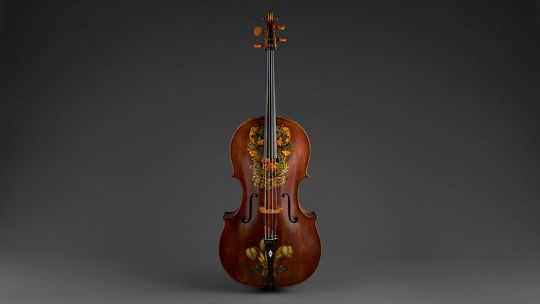

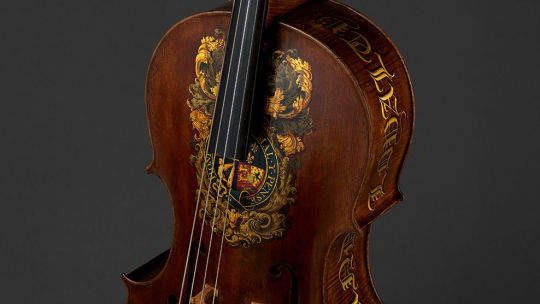


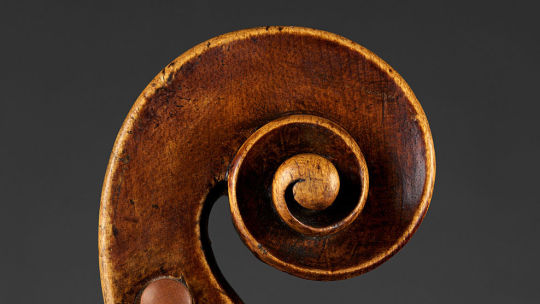
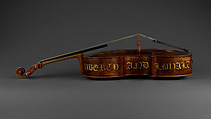
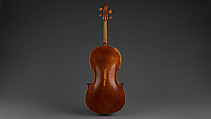
This absolutely magnificent piece of craftsmanship was either created in 1782 or during his time as Prince Regent between 1811 and 1820. Either way, it is simply stunning. It was crafted by a man named William Forster, a man whose family had long been making instruments. Forester had also crafted at least one violin for George’s younger brother Prince Ernest, the Duke of Cumberland. I cannot tell you enough how badly I want to play on this cello. If you look closely, you can see the marks of use. This cello, although still in excellent condition, has clearly been used. This is especially easy to spot on the back of the cello where the colour coat has been rubbed of where the instrument had been leaning against the players body. It seems as sadly the bow that accompanied the cello was lost sometime or had been destroyed.
In the third episode of the TV-series “Prince Regent��� we can see George playing the cello for some guests. I would have love to see a reproduction of this particular instrument but alas the film team went for a much more subtle cello. (Fun fact as a sidenote: I may or may not have actually named my own cello George - is that strange?)
174 notes • Posted 2021-03-13 06:31:17 GMT
Get your Tumblr 2021 Year in Review →
11 notes
·
View notes
Text

Task 007. Which Character Are You?
Mike Delfino (Desperate Housewives): 84%
Troy Bolton (High School Musical): 84%
Benjamin Miles 'C-Note' Franklin (Prison Break): 83%
Archie Andrews (Riverdale): 83%
Robb Stark (Game of Thrones): 82%
Jacob Black (Twilight): 82%
Lincoln Burrows (Prison Break): 82%
Bellamy Blake (The 100): 82%
Curt Vaughan (The Cabin in the Woods): 82%
Jamie Fraser (Outlander): 82%
Vander (Arcane): 82%
Will Turner (Pirates of the Caribbean): 81%
Ka D'Argo (Farscape): 81%
Tyler Locke (Locke & Key): 81%
Rand al'Thor (Wheel of Time): 81%
3 notes
·
View notes
Photo








― prison break the final break // 5x01
#prisonbreakedit#pbedit#prisonbreakgifs#prison break#michael scofield#lincoln burrows#prison break spoilers#alex mahone#benjamin c note franklin#mine*#pb s5
133 notes
·
View notes